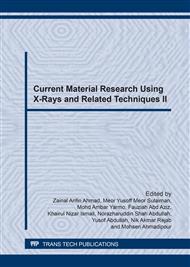p.333
p.338
p.344
p.348
p.353
p.357
p.365
p.373
p.377
Study of Eleiodoxa conferta (Kelubi) Fruit as Dye-Sensitized Solar Cell (DSSC) for Energy Conversion Efficiency
Abstract:
Dye-Sensitizer Solar Cell (DSSC) is preferable because it is mimicking of photosynthesis that able to use any extraction from organic substances so it is more eco-friendly and economically device in utilising photon as source of electricity. Therefore, this is a fundamental study and the purpose is to investigate the extend ability of extraction from Eleiodoxa conferta fruit parts (young flesh, pickled flesh and seed) using DSSC in order to generate electricity. The energy conversion efficiency of the assembled DSSCs is compared by conducting current-voltage measurements based on the titanium dioxide (TiO2) thickness and dye-sensitizer use. Results show only pickled flesh contained both crystalline (18.9%) and amorphous (81.1%) structure and proven other samples (young flesh and seed) were organic compound as the XRD pattern show noise peaks. The highest absorbance with peak range of wavelength between 555 nm to 565 nm of 70% concentration of young flesh extraction gives 3.74 a.u.. Meanwhile, the best performance of DSSC was recorded by young flesh with 2 layer thicknesses of TiO2 with open circuit, Voc = 0.663 V, short circuit, Isc= 0.077 mA, fill factor, FF= 0.84 gives 0.43% efficiency of current-voltage measurement.
Info:
Periodical:
Pages:
353-356
Citation:
Online since:
March 2017
Authors:
Keywords:
Price:
Сopyright:
© 2017 Trans Tech Publications Ltd. All Rights Reserved
Share:
Citation:


